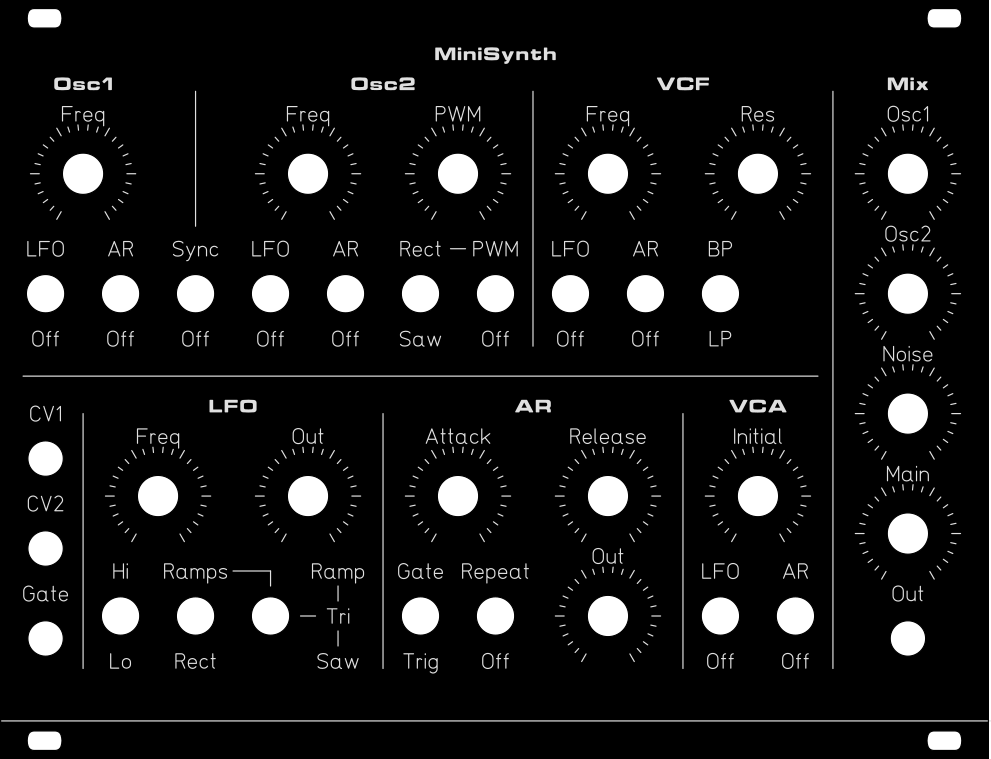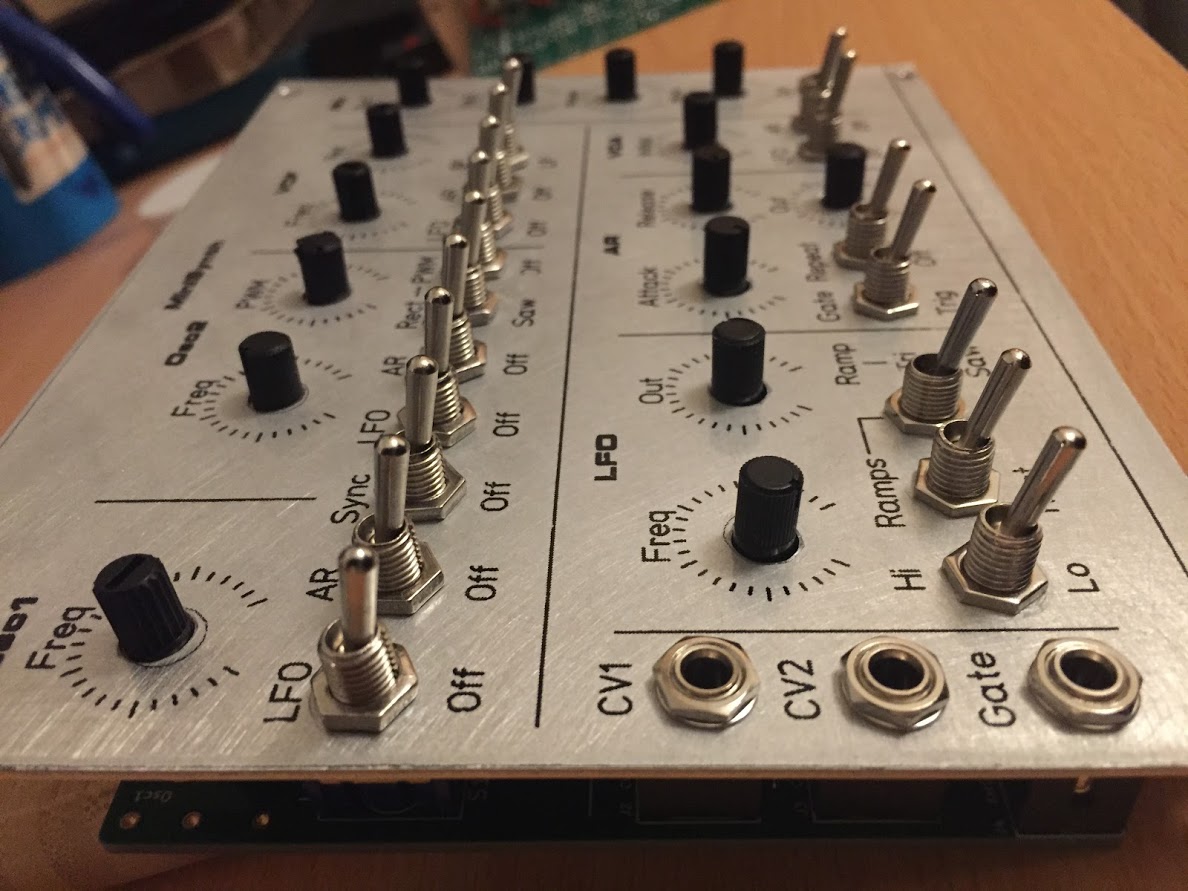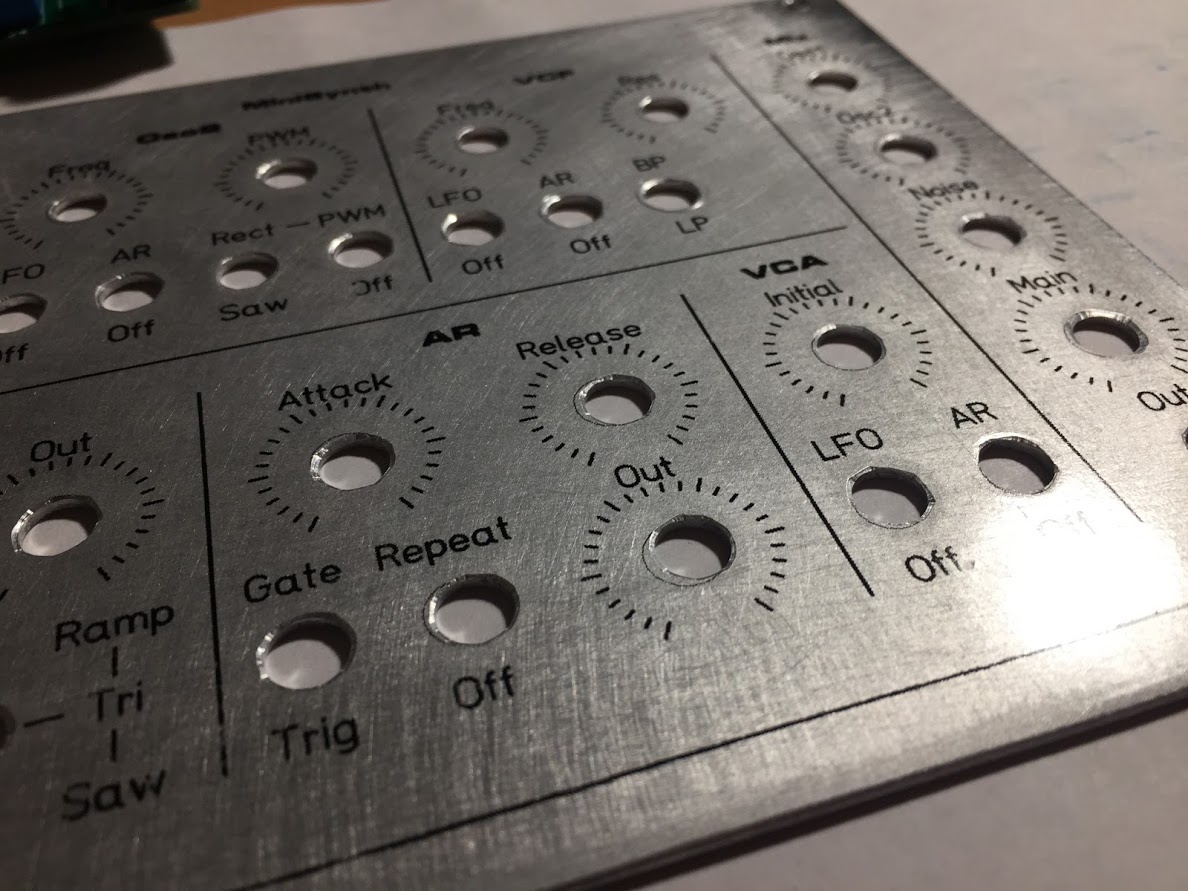The SMT adaptation was a hobby project. The MFOS designs are the property of SynthCube.
If you want to buy PCB for the MFOS synths, please visit musicfromouterspace.com
MFOS Sound Lab Mini-Synth is a cool analog monophonic synthesizer. The original version has been created by Ray Wilson from Music From Outer Space.

There is an updated version available. Please, check the latest informations here.
This is the build documentation for version 1.3. It’s an update from V1.2 documentation.
The SLMS is composed of:
- two VCOs (Saw and Saw+PWM),
- one Envelope Generator (AR, re trig-able),
- one LFO,
- one VCF,
- one VCA
- and one Noise source.
All the elements are internally routed. LFO and AR Envelope can modulate (On/Off) all the other elements.
See the diagram below for a graphical representation of the internal wiring.

Tom Fenn of Birmingham, UK. It will help you imagine the sounds you can make.”
(C) http://musicfromouterspace.com
You’ll find more details and explanations of the different circuits, the complete theory of operation, etc. on MFOS website.
The SMT Edition, version 1.3
The SMT Edition has been specifically designed to fit in a Eurorack System (Power input: -12, 0, +12 volts) and it removes any extra wiring. It’s a one board solution.

While the original is designed in Through Hole Technology (TH), this version is in Surface Mount Technology (SMT).
Some beginners might find the SMT is more difficult to solder (smaller parts) than TH. But with a bit of technique and experience, SMT is as easy as TH, and maybe sometimes, easier. Besides, the SLMS uses the bigger 1206 size components. Those are easier to solder.
Same circuit…
The electrical circuit is identical to the original SLMS. Also, it does not include all the later optional mods suggested by Ray.
I strongly recommend to read the original documentation.
Cross reference between the two versions is easy: the part references and values are identical. R1 in SMT version is R1 in Ray’s original version, and so on.
… with a few adaptations
The conversion from Through Hole to SMT required some component updates:
- The FET transistors (MPF102) Q5 and Q6 have been replaced by two BF545 or equivalents (MMBFJ310, MMBFJ211, MMBFJ202, MMBF4392LT1G, MMBFJ309LT1G and BFR31 have been tested ok).
- The four NPN transistors (2N3904) Q1, Q2, Q3 and Q4 have been replaced by two NPN arrays BC847BS. They are kind-of-matched and as the two transistors share the same package (different substrate though) they present an overall good thermal coupling.
Adaptation to Eurorack Power Bus is straightforward:
- The power input is connected through diodes D101 and D102.
Build instructions
The assembly is simple. No kludge, bodge, correction, mod or anything else is required to make it work.
There’s a Sync Mod Board available though, to improve the Sync behaviour between the two VCOs. It also dramatically improves the tracking on VCO2.
The Surface Mount Components
SMT soldering is easier than what it looks like. No need for special tools or any special soldering iron or tip.
I recommend to use a thin solder wire. 0.3mm is good. 0.5mm is ok.
Get a good pair of fine, non magnetic, tweezers.
The Interactive BOM/Pick and Place Map will help you with the placement of the SMT components. It is also a convenient tool if you need to debug your board. Click on any pad to highlight the other same net pads.
Usually, it is recommended to solder the smallest parts first. Taller components can block the access to some pads.
Start with ICs. The white dot mark on PCB represents the pin #1. The thick band represents the side with pin #1 and is also the side of the “slanted edge” on the SOIC packages.
Next step are resistors. Begin with the largest group of the same value resistors, for instance, the 100k group. Then continue with decreasing group sizes.
Resistors are not polarized.
Tip: place the resistors in the same orientation, in order to be able to read the value codes without the need to rotate your board.
Ceramic capacitors come next. They are quite similar to the resistors: No polarity. Also they have no markings to differentiate them. So do not mix values! Work with one value at a time.
The ceramic capacitors require some special attention:
Ceramic caps are fragile. They can break easily if bent, twisted, squeezed, heated too much… You wont notice a broken cap, until it fails either open or worse, closed (short circuit!)
Continue with SOT transistors and SOD diodes. Prefer SOD 323 over SOD 323F. Attention, D8 is the Zener Diode.
The most challenging parts to solder are the two transistor arrays Q1 and Q2 (SOT 363 package). Fortunately, the BC847BS doesn’t have a polarity (the parts are in fact symmetrical) so just focus your attention to correctly align the pins to the PCB pads. Check for possible shorts between the pins. You can add flux before soldering, it will help the solder to flow correctly.
Finish with the aluminum capacitors. Those caps are polarized. Align both the PCB and the component markings.
The Through Hole Components
Now it’s time to solder the Through Hole Components. Here’s my recommended order:
Flip your board and solder the noise transistor: either Q7 or Q101. 2N3904 (Q7) are good Noise sources. Use Q101 if you have BC547. Use only one of them, not both.
Flip again your board and solder the 10 pin Eurorack Power Connector K101. Pay attention to the orientation. The connector must face the rear of the PCB (opposite to controls) and it is crucial to align pin #1. Pin #1 has a small silkscreen triangle.
Now is a good time to solder the Tempco resistors R60 and R61. They are mounted on TOP of the Transistor Arrays Q1 and Q2. Place them in contact with the arrays. Use a small amount of thermal grease to improve the thermal coupling.
The Bottom side of the board is now complete (connector S1 is optional).
It’s time to solder the remaining TH components, starting as usual with the smallest ones.
The trim potentiometers RM1, RM3, R201 and R303 come first. Orient the screw heads toward the outside so that you’ll be able to adjust them once the front panel is in place.
If you already have the front panel, it’s best to use it now. It will help you align correctly the controls:
Place the four jack connectors, flip the board and, for now, solder only one pad of each.
Potentiometers might have a protruding tab that you must remove before. Use pliers to remove them.
Then, snap them in place on the PCB. Pay attention to the values: R10 and R11 are 1Meg Ohms. You might also need to remove the nuts and washers.
Solder one of the two outer mechanical pins on each pot.
Now you can either first put in place the switches on the PCB, solder just one pin of each, then try to correct the alignment (inclination) while reflowing the solder. (you can use the front panel to help you in the process).
Or, highly recommended, you can simply bolt the switches to the front panel first and then position the front panel over the PCB and adjust the rotation of the switches so that everything fits nicely in place.
Pay attention to S16. It’s the only 3 position switch (On-Off-On). If your switches come with 2 washers and 2 nuts, keep only 1 of each.
Bolt some potentiometers in order to secure the front panel. Also bolt the jack sockets to correctly align them.
Once the front panel is in place and the controls are securely bolt, reflow the pre-soldered pins of the potentiometers, the switches and the jack sockets to release the tension on the pads.
Finally, solder the remaining pins.
First tests and calibrations
Before plugging in any power source, double check your job! If there’s a short circuit anywhere on the board, some damages can occur.
Check the orientation of polarized components.
To search for short circuits on the power rails, use a ohmmeter or a continuity tester on test points TP601, TP602, TP603. No value should be under few hundreds ohms.
Power your board with -12, 0, +12 volts (see “power connector” diagram on the board). A thick white band on the PCB indicates the -12V rail (usually the “red stripe” on your ribbon cable).
Check the values again at TP601/TP603 and TP602/TP603. You should read values above +/-11V.
Plug a jack on the output socket. You should get a signal with switches on off position, VCO pots in mid position, VCF “Freq” pot on mid position, VCA pot on full clockwise, the mixer pots on full clockwise position.
For more information on how to test, debug and calibrate your synth, please read Ray’s original documentation.
The Front Panel

You can find the CAD file download link in the Downloads section below.
Michele (Modular Audio Devices) has designed this amazing panel, using KiCad. Contact him if you want one:

BOM
For a complete list of components, suggested sellers and parts, sorted by values, with refs and comments, see Google Calc document or below in Downloads section.
There’s also an interactive BOM available.
Temperature Compensation Resistors
Temperature Compensation Resistors R60 and R61 can be found at Thonk Tempco Resistor – Akaneohm 1% 3300ppm
However, it’s possible to use simple 50ppm/°C resistors instead. Your VCOs will work, track the 1V/octave CV input but will be out of tune as soon as the temperature will change.
Switches
All switches are SPDT (Single Pole, Double Throw) with the exception of S16, which is a “3 position On-Off-On” SPDT with an additional central position (No Contact).
SPDT is ON – ON (Mouser: 506-A101SYZQ04)
SPDT “3 position” is ON – OFF – ON (Mouser: 506-A103SYZQ04)
The two Mouser refs should be ok for the job.
Sources for pots and jacks:
Potentiometers:
- https://www.thonk.co.uk/shop/alpha-9mm-pots/
- http://smallbear-electronics.mybigcommerce.com/alpha-single-gang-9mm-right-angle-pc-mount/
- https://www.musikding.de/Pot-9mm-100k-lin-Print-vertical
10 mm height Jacks (PJ398SM / “Thonkicon”):
- https://www.thonk.co.uk/shop/3-5mm-jacks/
- http://www.qingpu-electronics.com/en/products/WQP-PJ398SM-362.html
Downloads
- Schematics (PDF)
- Front Panel Express design, Black/natural engraving (euro slms 33hp 20180821.fpd)
- SVG version of Front Panel (euro-slms-33hp-20180821.svg)
- Front Panel dimensions (slms-33hp-20180821-dimensions-20200406.pdf)
Gallery



SLMS made by other users
Csaba made this gorgeous aluminum panel with the Toner Transfer method:




Greetings and salutations David, absolutely stunning work. Just wondering if you have any of your eurorack MFOS PCBs available?
Thanks in advance
Jef